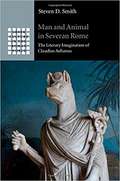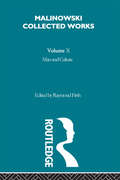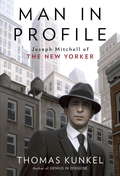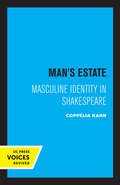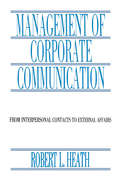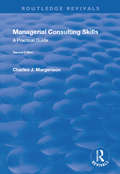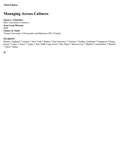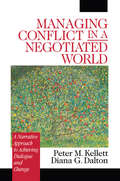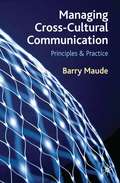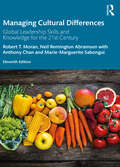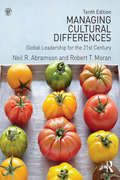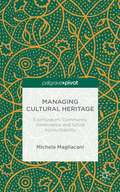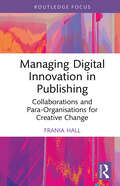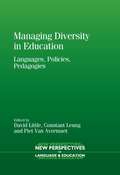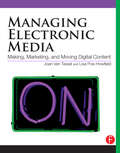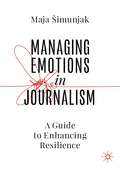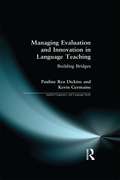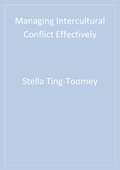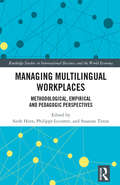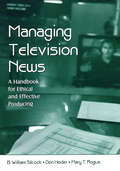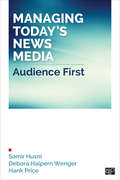- Table View
- List View
Man and Animal in Severan Rome
by Steven D. SmithThe Roman sophist Claudius Aelianus, born in Praeneste in the late second century CE, spent his career cultivating a Greek literary persona. Aelian was a highly regarded writer during his own lifetime, and his literary compilations would be influential for a thousand years and more in the Roman world. This book argues that the De natura animalium, a miscellaneous treasury of animal lore and Aelian's greatest work, is a sophisticated literary critique of Severan Rome. Aelian's fascination with animals reflects the cultural issues of his day: philosophy, religion, the exoticism of Egypt and India, sex, gender, and imperial politics. This study also considers how Aelian's interests in the De natura animalium are echoed in his other works, the Rustic Letters and the Varia Historia. Himself a prominent figure of mainstream Roman Hellenism, Aelian refined his literary aesthetic to produce a reading of nature that is both moral and provocative.
Man and Culture: An Evaluation of the Work of Malinowski [1957]
by Bronislaw MalinowskiThis volume is a reassessment of Malinowski's work by a group of his former pupils and colleagues. A frank evaluation, not a eulogy, it examines the real and lasting importance of Malinowski's contribution to a range of subjects.
Man in Profile
by Thomas KunkelThis fascinating biography reveals the untold story of the legendary New Yorker profile writer--author of Joe Gould's Secret and Up in the Old Hotel--and unravels the mystery behind one of literary history's greatest disappearing acts. Born and raised in North Carolina, Joseph Mitchell was Southern to the core. But from the 1930s to the 1960s, he was the voice of New York City. Readers of The New Yorker cherished his intimate sketches of the people who made the city tick--from Mohawk steelworkers to Staten Island oystermen, from homeless intellectual Joe Gould to Old John McSorley, founder of the city's most famous saloon. Mitchell's literary sensibility combined with a journalistic eye for detail produced a writing style that would inspire New Journalism luminaries such as Gay Talese, Tom Wolfe, and Joan Didion. Then, all of a sudden, his stories stopped appearing. For thirty years, Mitchell showed up for work at The New Yorker, but he produced . . . nothing. Did he have something new and exciting in store? Was he working on a major project? Or was he bedeviled by an epic case of writer's block? The first full-length biography of Joseph Mitchell, based on the thousands of archival pages he left behind and dozens of interviews, Man in Profile pieces together the life of this beloved and enigmatic literary legend and answers the question that has plagued readers and critics for decades: What was Joe Mitchell doing all those years? By the time of his death in 1996, Mitchell was less well known for his elegant writing than for his J. D. Salinger-like retreat from the public eye. For thirty years, Mitchell had wandered the streets of New York, chronicling the lives of everyday people and publishing them in the most prestigious publication in town. But by the 1970s, crime, homelessness, and a crumbling infrastructure had transformed the city Mitchell understood so well and spoke for so articulately. He could barely recognize it. As he said to a friend late in life, "I'm living in a state of confusion." Fifty years after his last story appeared, and almost two decades after his death, Joseph Mitchell still has legions of fans, and his story--especially the mystery of his "disappearance"--continues to fascinate. With a colorful cast of characters that includes Harold Ross, A. J. Liebling, Tina Brown, James Thurber, and William Shawn, Man in Profile goes a long way to solving that mystery--and bringing this lion of American journalism out of the shadows that once threatened to swallow him. Praise for Man in Profile "[An] authoritative new biography [about] our greatest literary journalist . . . Kunkel is the ideal biographer of Joseph Mitchell: As . . . one of the great authorities on the ethos of both the magazine (a world all its own, to be sure) and New York newspapers in their picaresque heyday. Better still, he's a writer and craftsman worthy of his subject."--Blake Bailey, The New York Times Book Review (Editor's Choice) "A richly persuasive portrait of a man who cared about everybody and everything."--London Review of Books"Mitchell's life and achievements are brought vividly alive in [this] splendid book."--Chicago Tribune"A thoughtful and sympathetic new biography."--Ruth Franklin, The Atlantic "Excellent . . . A first-rate Mitchell biography was very much in order."--The Wall Street JournalFrom the Hardcover edition.
Man's Estate: Masculine Identity in Shakespeare
by Coppelia H. KahnThis title is part of UC Press's Voices Revived program, which commemorates University of California Press’s mission to seek out and cultivate the brightest minds and give them voice, reach, and impact. Drawing on a backlist dating to 1893, Voices Revived makes high-quality, peer-reviewed scholarship accessible once again using print-on-demand technology. This title was originally published in 1981.
Management of Corporate Communication: From Interpersonal Contacts To External Affairs (Routledge Communication Ser.)
by Robert L. HeathWhereas many organizational communication texts address internal communication processes, few consider the efforts that companies expend to communicate with external stakeholders. Likewise, many texts that concentrate on public relations or advertising consider external communication, but fail to give attention to internal communication. Combining both points of view, this text explains how an entire organization operates through enactments of personnel and external stakeholders. Central to this book is a concern for meaning and its influence on the performance of jobs in response to expectations of co-workers and external publics. The concept of narrative is used to explain how individual and organization performance is the expression of personae that are best when enacted jointly -- in varying degrees of coordination -- to satisfy mutual performance expectations. Narrative explains the power of organizational meaning, interpersonal contacts, group performance, stakeholder negotiation, and internal and external organizational zones of meaning -- assumptions that are shared by people who enact an organization through coordinated efforts.
Managerial Consulting Skills: A Practical Guide (Routledge Revivals)
by Charles J. MargerisonThis title was first published in 2001. The advisory role in organizations is more important today than it has ever been. To perform effectively, managers and professionals need the skills of the consultant. This manual is designed to provide practical help for all advisers, whether working within or outside the organization. It covers every aspect of the process, from interpersonal skills to organizational context, from planning to follow-up. This second edition reflects developments which have taken place since the publication of the first edition and now includes ten chapters on the impact that action learning has on change processes and the way that the Web is likely to influence consulting. Each chapter concludes with guidelines summarizing the content, and questions designed to help the reader to apply the material to his or her own activities. Real-life cases from Dr Margerison's own experience are included, as well as examples drawn from the work of many well-known consultants.
Managing Across Cultures
by Susan Schneider Jean-Louis Barsoux Günter StahlThis is a book about managing across cultures: the threats and opportunities, the problems and possibilities. Rather than experiencing cultural differences as threats to be overcome or as unfortunate remnants of history to be endured, we challenge the reader to experience and enjoy the richness of cultural differences. Rather than creating a cultural melting pot, we need to design organisations as cultural mosaics in which each element preserves its unique value.
Managing Conflict in a Negotiated World: A Narrative Approach to Achieving Productive Dialogue and Change
by Dr Peter M. Kellett Diana G. DaltonKellett and Dalton present a core text in Conflict Management derived from extensive class testing of their material. Their book helps readers understand the elements of conflict and act on that understanding by managing conflict better in each area of their lives - work, family, and community.
Managing Conflict in a Negotiated World: A Narrative Approach to Achieving Productive Dialogue and Change
by Diana G. Dalton Dr. Peter M. KellettKellett and Dalton present a core text in Conflict Management derived from extensive class testing of their material. Their book helps readers understand the elements of conflict and act on that understanding by managing conflict better in each area of their lives - work, family, and community.
Managing Cross-cultural Communication: Principles And Practice
by Barry MaudeAn accessible and lively introduction to the management of cross-cultural communication for undergraduate and graduate business students. Drawing on the latest research and incorporating the author's own extensive experience of working in different cultural settings, it addresses the core theory and practice. An essential course companion.
Managing Cultural Differences: Global Leadership Skills and Knowledge for the 21st Century
by Robert T. Moran Neil Remington Abramson Anthony Chan Sabongui Marie-MargueriteIn today’s global business environment, it is vital that individuals and organizations have sophisticated global leadership skills. Communication and understanding of different cultures are paramount to business success. This new edition of the bestselling textbook Managing Cultural Differences guides students and practitioners to an understanding of how to do business internationally, providing practical advice on how competitive advantage can be gained through effective cross-cultural management. The digitization of the workplace, the integration of artificial intelligence into workplace cultures, cultural responses to crisis, and the value of diversity and inclusion are just a few examples of contemporary issues discussed in this text. This latest edition also begins with a completely new introductory chapter, which provides an overview and connects the themes between chapters for an integrated understanding of the topic. With a wealth of new examples, case studies, and online materials, this textbook is required course reading for undergraduates, postgraduates, and MBA students alike, as well as being a vital tool for anybody selling, purchasing, traveling, or working internationally.
Managing Cultural Differences: Global Leadership for the 21st Century (Managing Cultural Differences Ser.)
by Robert T. Moran Neil Remington AbramsonIn today’s global business environment, it is vital that individuals and organizations have sophisticated global leadership skills. Communication and understanding of different cultures is paramount to business success. This new edition of the bestselling textbook, Managing Cultural Differences, guides students and practitioners to an understanding of how to do business internationally, providing practical advice on how competitive advantage can be gained through effective cross-cultural management. Crises in the Middle East, the weakening of some emerging markets, and the value of diversity and inclusion are just a few examples of contemporary issues discussed in this text, which also introduces a completely new chapter on global business ethics. With a wealth of new examples, case studies, and online materials, this textbook is required course reading for undergraduates, postgraduates, and MBA students alike, as well as being a vital tool for anybody selling, purchasing, traveling, or working internationally.
Managing Cultural Heritage: Ecomuseum, Community Governance and Social Accountability
by Michela MagliacaniManaging Cultural Heritage explores managerial and governance issues within the cultural heritage sector, with particular regard to the ecomuseum. Moreover, a social accountability model is supplied to ecomuseums in order to be accountable towards its shareholder, the local community.
Managing Digital Innovation in Publishing: Collaborations and Para-Organisations for Creative Change
by Frania HallReflecting proactively on a growing industry 'dilemma', this book explores how publishing businesses can and do successfully experiment and innovate in digital publishing through collaboration.Many sectors of publishing are still structured around print production, with digital innovation in the consumer arena generally focused on different book formats, such e-books and audiobooks, rather than on brand-new types of products. Publishers need to innovate around different sorts of content and digital formats as consumers change their media habits. However, their pricing, business and risk models, and workflows are reflective of a legacy of print publishing; and as print commands so much revenue, publishers do not want to derail their main business as they experiment. Drawing on an analysis of collaboration and network theory and four in-depth qualitative case studies in different sectors, this research suggests that collaboration, particularly engaging with the wider creative sector, is key to the sustainable development of new types of products. It points to the characteristics of a successful digital collaboration and explains how to manage publishing innovation alongside the existing business, through para-organisations. Considering novel approaches to innovation, such as iterative software-style approaches and agile project management, as well as new business models, such as those employed in games development, the author shows how introducing new people – from software developers to competitors – can help instill a collaborative mindset within the organisation and facilitate constructive experimentation.Managing Digital Innovation in Publishing will be of interest to upper-level students and researchers of (digital) publishing and related creative industries.
Managing Diversity in Education
by David Little Constant LeungDiversity - social, cultural, linguistic and ethnic - poses a challenge to all educational systems. Some authorities, schools and teachers look upon it as a problem, an obstacle to the achievement of national educational goals, while for others it offers new opportunities. Successive PISA reports have laid bare the relative lack of success in addressing the needs of diverse school populations and helping children develop the competences they need to succeed in society. The book is divided into three parts that deal in turn with policy and its implications, pedagogical practice, and responses to the challenge of diversity that go beyond the language of schooling. This volume features the latest research from eight different countries, and will appeal to anyone involved in the educational integration of immigrant children and adolescents.
Managing Electronic Media: Making, Moving and Marketing Digital Content
by Joan Van TasselThis college-level media management textbook reflects the changes in the media industries that have occurred in the past decade. Today's managers must address new issues that their predecessors never faced, from the threats of professional piracy and casual copying of digital media products, to global networks, on-demand consumption, and changing business models. The book explains the new new vocabulary of media moguls, such as bandwidth, digital rights management, customer relations management, distributed work groups, centralized broadcast operations, automated playlists, server-based playout, repurposing, mobisodes, TV-to-DVD, and content management. The chapters logically unfold the ways that managers are evolving their practices to make content, market it, and deliver it to consumers in a competitive, global digital marketplace. In addition to media companies, this book covers management processes that extend to all content-producing organizations, because today's students are as likely to produce high-quality video and Web video for ABC Computer Sales as they are for the ABC Entertainment Television Network.
Managing Emotions in Journalism: A Guide to Enhancing Resilience
by Maja ŠimunjakThis textbook offers the first practical guide to managing emotions in everyday journalism work based on interviews with more than 30 British journalists. It raises awareness of emotional situations and stressors journalists may face, so practitioners are better able to recognise these and prepare for them, and outlines practical emotion management strategies which they can apply to enhance their emotional intelligence and resilience and consequently, feel and perform better in the workplace. It includes vignettes written by journalists from the United Kingdom, United States, Australia and Croatia, as well as practical scenario exercises that prompt readers to reflect on how they would feel and react in specific situations based on journalists’ everyday work.
Managing Evaluation and Innovation in Language Teaching: Building Bridges (Applied Linguistics and Language Study)
by Pauline Rea Dickins Kevin GermaineManaging Evaluation and Innovation in Language Teaching focuses on the connections to be made between evaluation and change in language education with a specific focus on English Language Teaching. The book demonstrates the central importance of evaluation in relation to language projects and programmes, the management of change and innovation, and in improving language teacher development. The introductory chapter provides an overview of the present trends in evaluation as well as offering examples of recent evaluation projects. Subsequent chapters identify contemporary issues in evaluation and their relevance to language teaching, covering a number of cultural and ethnographic studies in evaluation management in different world-wide contexts, as well as drawing insights from other related disciplines. The editors seek to draw attention to the possibilities of inter-disciplinary exchange to inform the reader of current practice, and highlight emerging issues in the expanding field of evaluation in language teaching, especially in ELT. The contemporary nature of the studies presented here will be relevant to both post graduate students following language education programmes as well as to professionals involved in language teaching. It will be of particular interest to those involved in the management of innovation and the evaluation of projects and programmes, such as curriculum developers, Director of Studies, and professionals with a special responsibility for bringing about change in language teaching contexts.
Managing Intercultural Conflict Effectively
by Dr Stella Ting-Toomey Dr John G. OetzelIn this volume, Ting-Toomey and Oetzel accomplish two objectives: to explain the culture-based situational conflict model, including the relationship among conflict, ethnicity, and culture; and, second, integrate theory and practice in the discussion of interpersonal conflict in culture, ethnic, and gender contexts. While the book is theoretically directed, it is also a down-to-earth practical book that contains ample examples, conflict dialogues, and critical incidents. Managing Intercultural Conflict Effectively helps to illustrate the complexity of intercultural conflict interactions and readers will gain a broad yet integrative perspective in assessing intercultural conflict situations. The book is a multidisciplinary text that draws from the research work of a variety of disciplines such as cross-cultural psychology, social psychology, sociology, marital and family studies, international management, and communication.
Managing Interpersonal Conflict
by William A. DonohueThis book explores the process of interpersonal conflict - from the initial decision as to whether or not to confront differences through to how to plan the actual confrontation. It deals extensively with negotiation and, where negotiation proves unsuccessful, with third-party dispute resolution. To avoid destructive or violent behaviour, Donohue emphasizes the importance of keeping conflicts under control and of focusing on the pertinent issues. He argues that the key to managing conflict is to address differences collaboratively so that the parties can create better solutions and, ultimately, strengthen their relationships.
Managing Interpersonal Conflict: Advances through Meta-Analysis (Routledge Communication Series)
by Mike Allen Barbara Mae Gayle Raymond W. Preiss Nancy A. BurrellManaging Interpersonal Conflict is a systematic review of conflict research in legal, institutional and relational contexts. Each chapter represents a summary of the existing quantitative social science research using meta-analysis, with contexts ranging from jury selection to peer mediation to homophobia reduction. The contributors provide connections between cutting-edge scholarship about abstract theoretical arguments, the needs of instructional and training pedagogy, and practical applications of information. The meta-analysis approach produces a unique informational resource, offering answers to key research questions addressing conflict. This volume serves as an invaluable resource for studying conflict, mediation, negotiation and facilitation in coursework; implementing and planning training programs; designing interventions; creating workshops; and conducting studies of conflict.
Managing Multilingual Workplaces: Methodological, Empirical and Pedagogic Perspectives (Routledge Studies in International Business and the World Economy)
by Susanne Tietze Sierk Horn Philippe LecomteThis book sets new trajectories for language-sensitive business and management research and pedagogy. The existence of language plurality characterises these. Empirical studies have been established as important and relevant for contemporary research. It has shifted language-sensitive research from the periphery to the centre of international management research. However, this field is rapidly changing, and new thematic approaches have begun to emerge. By addressing this, the book offers genuine and more nuanced insights into existing themes and comes with applications of emergent conceptual developments in different settings. The second part of the book covers methodologies and gives examples and cutting-edge insights into the role of translation in the execution of empirical research and theorising arising from it. Finally, the book draws together innovative ways of how to address the challenges of a multilingual teaching classroom and how to innovate in order to incorporate such diversity through pedagogic practice. This book provides a source that unites insights from multilingual empirical research, methodological considerations and pedagogic practice in order to advance knowledge and debate. It will be a ‘handy source’ of information that offers direct access to the latest guidance on language-sensitive management challenges. It will, therefore, appeal to an internationally-minded and mobile audience, including scholars, students and decision-makers.
Managing Television News: A Handbook for Ethical and Effective Producing (Routledge Communication Series)
by B. William Silcock Don Heider Mary T. RogusManaging Television News provides a practical introduction to the television news producer, one of the most significant and influential roles in a newscast. Recognizing the need for formal training in this key role, authors B. William Silcock, Don Heider, and Mary T. Rogus have combined their expertise and experience to shape this essential resource on the responsibilities, demands, and rewards of the news producer position. Their book provides a strategic approach to producing newscasts and serves as an in-depth guide to creating quality, audience-friendly newscasts working within the realistic limitations of most newsrooms. It helps the student and the professional producer sort through the various deadline-driven challenges of creating a 30-minute newscast. Filled with real-world examples and advice from news directors, producers, and anchors currently in the business, and photographs illustrating the varied perspectives in the position, Managing Television News provides critical skill sets to help resolve ethical dilemmas, as well as keen and fresh insights on how to win the ratings without compromising news quality. Career concerns are also addressed. This resource is a pioneering book for the professional television newsroom and the individual reader interested in starting or expanding a producing career. It is an excellent text for the college classroom, as its structure fits neatly into a semester schedule, and it is a must-have resource for both seasoned and novice producers, as well as students in broadcast news.
Managing Today’s News Media: Audience First
by Samir A. Husni Debora R. Wenger Hank PriceThe business of journalism is in the midst of massive change. Managing Today’s News Media: Audience First offers practical solutions on how to cope with and adapt to the evolving media landscape. News media experts Samir Husni, Debora Halpern Wenger, and Hank Price introduce a forward-looking framework for understanding why change is occurring and what it means to the business of journalism. Central to this new paradigm is a focus on the audience. The authors introduce “The 4Cs Strategy” to describe how customers, control, choice, and change are all part of a strategy for successful media organizations. Real-world case studies, important theoretical grounding, and a focus on understanding rather than resisting the customer’s desire for choice and control make this an unbeatable resource for students and managers alike who want to succeed in this changed media business landscape.
Managing Today’s News Media: Audience First
by Samir A. Husni Debora R. Wenger Hank PriceThe business of journalism is in the midst of massive change. Managing Today’s News Media: Audience First offers practical solutions on how to cope with and adapt to the evolving media landscape. News media experts Samir Husni, Debora Halpern Wenger, and Hank Price introduce a forward-looking framework for understanding why change is occurring and what it means to the business of journalism. Central to this new paradigm is a focus on the audience. The authors introduce “The 4Cs Strategy” to describe how customers, control, choice, and change are all part of a strategy for successful media organizations. Real-world case studies, important theoretical grounding, and a focus on understanding rather than resisting the customer’s desire for choice and control make this an unbeatable resource for students and managers alike who want to succeed in this changed media business landscape.
